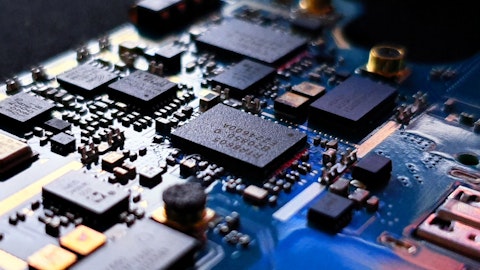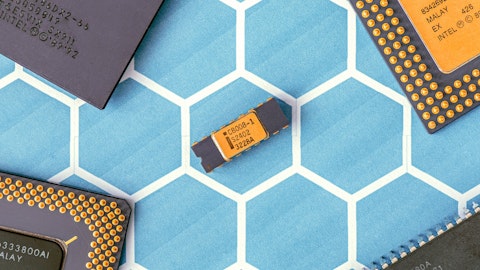Tore Svanberg: Sounds good and congrats on the progress. Thank you.
Paul Pickle: Thank you.
Operator: And the next question comes from the line of Craig Ellis with B. Riley Securities. Please proceed with your question.
Craig Ellis: Yeah, thanks for taking the question. And Mark thanks for the additional transparency with the convert dilution things you posted on the website. So, Paul, I wanted to start off with one for you and follow up a little bit on Tore’s question, but maybe take a longer-term view, would be helpful if you could provide some more color on things that you see as we look out over the course of calendar ’24, in data center, for example, what are some of the things that you’re really excited about in traditional data center versus hyperscale. And then similarly, what are some of the things you have your eyes on in base station and then in PON?
Paul Pickle: Okay, yeah, thank you for that question. I will say the data center, we’re pretty excited. I’m personally excited about data center. What we’re seeing there is just an absolutely rapid SAM expansion report expansion in data center. And I would really kind of bifurcate data center or hyperscale data centers into general compute bucket and an AI bucket, those are two very different applications. They have different needs and right now the appetite in AI is pretty insatiable. So we’re making grounds in general compute in 4 by 100 applications as well as, as you kind of look at just breakneck speeds in AI and so most of the volume that we ship today really is more 50-gig single lambda, I know kind of throw out 400-gig, 800-gig but we kind of look at, for us it’s a generation of device thing.
We look at 50-gig devices, we’re shipping 100-gig devices and we got out in the market, but are not shipping against those devices quite yet today, 200-gig single lambda that’s performing quite well and POCs. So as I kind of look out over the next several years, the massive growth that we expect to happen in AI — AI-driven data centers is just a significant upside opportunity for us and we’re well positioned to take advantage of that. So to me, this is across the board, small customer set very exciting opportunity to say the least.
Craig Ellis: Got it. And then you talked a little bit about needing to see tenders in PON but on the base station side of the business, anything standing out look at 2024.
Paul Pickle: Yeah. If you go back to ECOC, we did — we did a 1.6 terabit test case with Coherent, I should say demonstration and this was for 10-K, let’s call it mid-haul type applications. So, in terms of pushing up the speed or the availability to implement high-speed connections in both short-reach as well as mid-reach or long-reach applications both of them we’re well-positioned to take advantage of. So as infrastructure just drives data connectivity up and there’s that last mile that will happen naturally as well in both European and North American countries as well, China is important to us. There has been with all the infrastructure growth in multi-tenant dwelling growth their data connectivity has been really key. We would expect share in North America and Europe to creep up as they look to implement higher-speed applications as well.
So just released that 50-gig part as well. We’re looking at 25-gig adoption, but I think for from my standpoint, the tenders in January are going to give us a bit of a near-term effect as we continue to gain market share in other territories, which will give us a little bit more of a long-term tail as well.
Craig Ellis: Got it and then I’ll flip it over to Mark for the second topic and it’s on operating expense. So, Mark, very impressive guide, decreasing OpEx by 10% quarter-on-quarter to $75 million, and it sounds from the color that you provided that that decrease is structural. But I wanted to confirm that. And then if you could just any color on things we should expect as we look to 2024 with OpEx for example FICA impacts early in the year, any other optimizations that you might see coming. Thank you so much.
Mark Lin: Sure. Thanks for the question, Craig, it’s, we’ve got $74 million for next quarter and we’re pretty confident in hitting that number because the actions that we need to hit that number have really been taken. Of course, this could be seasonality in calendar Q1 with things like FICA resets, but we’re pretty comfortable staying around this neighborhood in terms of OpEx. There may be some incremental increases, slight incremental increases in R&D, but that’s just really timing.
Craig Ellis: Got it. Guys, congratulations on the progress. Thank you.
Paul Pickle: Thank you.
Mark Lin: Thanks.
Operator: And the next question comes from the line of Anthony Stoss with Craig-Hallum. Please proceed with your question.
Anthony Stoss: Hey, guys, Paul, I wanted to follow-up on the whole cellular module side of the business in your commentary, I’m just curious, a lot of these design wins that you’re lapping up now, when do they turn to production? And I’m curious if any of those customers are contemplating or having conversations with you about rip and replace kind of existing products that they already have say, with say Quectel or is it just kind of go-forward products and then I have a follow-up.
Paul Pickle: Yes. So as we kind of look at it. Most of the programs today that we’re bidding on or have captured, they are really kind of talking about the production starts near the end of the calendar year. So I would not characterize those as rip and replace. However, if there is — I will note that on the customer side, there’s a little bit of hesitancy in terms of forecasting, just because of some market uncertainty. So if there a little bit of bolstering and market confidence, I think people will start to mark some of these a little bit early, but right now they are kind of slated at the end of the calendar year. And there are additional wins and pickups that we’re noting, not additional follow-on programs that we’ve classically held.
If we get some additional scrutiny out of the China select committee, it’s highly possible that we’ll see some of those critical infrastructure applications look for an acceleration of nex-gen or that next design and that I would characterize a little bit more in terms of rip and replace. Because I don’t think somebody will pull module out of existing hardware without refreshing that hardware as well at least at this point.
Anthony Stoss: Got it. And then just a broader question on visibility, and also if you think your January revenue guide down a little bit sequentially. Do you think that marks the low on a quarterly basis going forward?
Paul Pickle: Yeah. So I think I’m remembering my comments from last earnings call, I was pretty confident on the last earnings call that we hit a bottom on the IC business, we continue to see that we’re making progress in moving forward on the IC business I think even though some of our peers, maybe are not seeing that we’ve corrected, a little bit earlier in the cycle and we continue to see that strength. At this point I don’t anticipate the hardware business getting any worse. I can say that, last quarter was a little early. We’re just starting to see that decline. We’ve seen some pretty good, let’s say, steady numbers out of the routers business, the modules business did pull back as we saw a little bit of a knee-jerk reaction at the customer base, where a lot of that direct business has had and the Fed buying I think was a little bit of a surprise as well for some of that customer base, where our product goes into.




